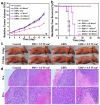Triphase interface synthesis of plasmonic gold bellflowers as near-infrared light mediated acoustic and thermal theranostics
- PMID: 24842342
- PMCID: PMC4227821
- DOI: 10.1021/ja503115n
Triphase interface synthesis of plasmonic gold bellflowers as near-infrared light mediated acoustic and thermal theranostics
Abstract
We present a novel gold bellflower (GBF) platform with multiple-branched petals, prepared by a liquid-liquid-gas triphase interface system, for photoacoustic imaging (PAI)-guided photothermal therapy (PTT). Upon near-infrared (NIR) laser irradiation, the GBFs, with strong NIR absorption, showed very strong PA response and an ultrahigh photothermal conversion efficiency (η, ∼74%) among the reported photothermal conversion agents. The excellent performance in PAI and PTT is mainly attributed to the unique features of the GBFs: (i) multiple-branched petals with an enhanced local electromagnetic field, (ii) long narrow gaps between adjacent petals that induce a strong plasmonic coupling effect, and (iii) a bell-shaped nanostructure that can effectively amplify the acoustic signals during the acoustic propagation. Besides the notable PTT and an excellent PAI effect, the NIR-absorbing GBFs may also find applications in NIR light-triggered drug delivery, catalysis, surface enhanced Raman scattering, stealth, antireflection, IR sensors, telecommunications, and the like.
Figures






References
-
- Lovell J. F.; Jin C. S.; Huynh E.; Jin H.; Kim C.; Rubinstein J. L.; Chan W. C. W.; Cao W.; Wang L. V.; Zheng G. Nat. Mater. 2011, 10, 324. - PubMed
-
- Huynh E.; Zheng G. Wiley Interdiscip. Rev.: Nanomed. Nanobiotechnol. 2013, 5, 250. - PubMed
-
- Zhang Z.; Wang L.; Wang J.; Jiang X.; Li X.; Hu Z.; Ji Y.; Wu X.; Chen C. Adv. Mater. 2012, 24, 1418. - PubMed
Publication types
MeSH terms
Substances
Grants and funding
LinkOut - more resources
Full Text Sources
Other Literature Sources
Medical
Miscellaneous

